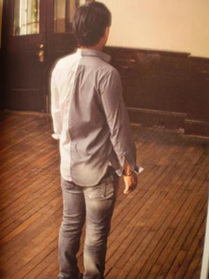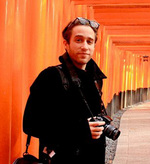French Hikikomori
Nicolas Tajan
Psychologist
«What is the major problem of youth in contemporary Japan ?» was the question I asked when I first came to Japan in August 2009. I had the intuition there should be issues related to new technologies: computers, internet, video games, mobile phones, etc... But I didn't expect the response of psychiatrists and philosophers: they told me there was an increase of Asperger Autism, Developpemental Disorders (hattatsu shôgai) and spoke about hikikomori (Saito, T., 1998). I was especially surprised of such a big phenomenon of social withdrawal in Japan. But at the same time it reminded me of situations I could deal with in my clinical practice of counseling with children and teenagers who have problems related to school.
 When I came back to France, I started to speak about hikikomori with my colleagues (physicians, psychiatrists, psychologists, psychoanalysts, social workers) and also to my friends. Everybody told me : «I know someone like that !», althought everytime I discussed longer with them, it appeared that the people they knew were not exactly «hikikomori» as described in Japan (Kaneko, S, 2006; Borovoy, A, 2008; Koyama, 2010). These people could be teenagers or young adults living with their parents, or by themselves in their apartment. In France, one can say there is effectively a hidden population of withdrawn youths very similar to hikikomori in Japan. Nevertheless, it is not a trend like french «otaku» or «cosplay», who can be identified as a group. Let's underline what are the main differences.
When I came back to France, I started to speak about hikikomori with my colleagues (physicians, psychiatrists, psychologists, psychoanalysts, social workers) and also to my friends. Everybody told me : «I know someone like that !», althought everytime I discussed longer with them, it appeared that the people they knew were not exactly «hikikomori» as described in Japan (Kaneko, S, 2006; Borovoy, A, 2008; Koyama, 2010). These people could be teenagers or young adults living with their parents, or by themselves in their apartment. In France, one can say there is effectively a hidden population of withdrawn youths very similar to hikikomori in Japan. Nevertheless, it is not a trend like french «otaku» or «cosplay», who can be identified as a group. Let's underline what are the main differences.
First, french people in a hikikomori-like situation don't gather in support groups, after their withdrawal as ex-hikikomori. Second, they don't have a special forum dedicated to hikikomori on the web. Third, there are no drama, manga or anime related to that topic. Fourth, french hikikomori-like situations don't imply a reference to «tôjisha» movement. Fifth, if hikikomori-like situations really exists in France, there is not a word such as «hikikomori»; a word that involves all the meaning located in «hikikomori» when japanese people use it.
The question «Does hikikomori exists outside Japan ?» (Kato & al, 2011) is here transformed: who are french social withdrawn youths? What could we learn of comparing them to the japanese hikikomori ? In that perspective it was necessary to build a multidisciplinary team of researchers in Japan and France. Japanese social scientists from Tokyo area (Horiguchi Sachiko, Shimizu Katsunobu, Teruyama Junko) and psychiatrists of Nagoya University (Suzuki kunifumi, Furuhashi Tadaaki, Ogawa Toyoaki, Tsuda Hitoshi) are meeting twice a year in Paris doing workshops and fieldwork. Our first results has been published in spring 2011 and involves 9 hikikomori clinical cases: 5 in Japan, 4 in France (Figueiredo & al., 2011). Since then, researchers from both countries were able to collect at least 15 cases of french people in hikikomori-like situations. We really hope the results to come will contribute to a better understanding of hikikomori.
 To conclude, we could say French young adults living in hikikomori-like situations can be considered as «retirants sociaux» and be compared with the japanese hikikomori in an transcultural research on social withdrawn youths. First, because we could find solutions for them to come back to society. Second, because we need to improve the quality of support of these people and their family.
To conclude, we could say French young adults living in hikikomori-like situations can be considered as «retirants sociaux» and be compared with the japanese hikikomori in an transcultural research on social withdrawn youths. First, because we could find solutions for them to come back to society. Second, because we need to improve the quality of support of these people and their family.
For Further informations on the evolution of this research and my Phd Dissertation please check my personal website (weekly updated). http://www.wix.com/nicolastajan/1
 Nicolas TAJAN
Nicolas TAJAN
Psychologist, PhD Candidate in Psychology.
He works at the frontier of Clinical Psychology, Mental Health Anthropology and Psychoanalysis. His research teams are Laboratory for Clinical & Intercultural Psychopathology (LCPI-Toulouse 2 University) and Center for Research in Medecine , Science, Health, Mental Health and Society (CERMES3/CNRS/Paris Descartes University). He's also associated to the parisian Center for Japanese Studies (CEJ-INALCO) through the research team on Childhood, Education and Society in Contemporary Japan (EESJC).
He's actually student researcher in Institute for Research in Humanities (Kyoto University) as a Japan Foundation Fellow.
Related Events
Back Issues
- 2019.8. 6 Unraveling the Maker…
- 2018.8.30 Japanese Photography…
- 2017.6.19 Speaking of Soseki 1…
- 2017.4.12 Singing the Twilight…
- 2016.11. 1 Poetry? In Postwar J…
- 2016.7.29 The New Generation o…
- 2016.4.14 Pondering "Revitaliz…
- 2016.1.25 The Style of East As…
- 2015.9.30 Anime as (Particular…
- 2015.9. 1 The Return of a Chin…

